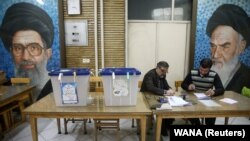No matter how popular it was with the Iranian and Western media, the categorization of the two leading political factions in Iran as Reformists and Conservatives has become obsolete for a long time now.
Neither the conservatives who call themselves Principalists, really adhere to any clear principle, nor the Reformists advocate real reforms by any standard.
The long-standing dispute of the two factions appears to be a struggle over political power and financial advantages. Otherwise, except the Khatami administration in its first term of office, there has not been much of a difference between eight years of the ultraconservative Ahmadinejad government and the seven years of the “moderate” Rouhani administration. In terms of domestic politics, civil liberties, suppression of dissent, financial corruption and poor and outdated foreign policy, their records are quite similar.
Political divides and splits within both factions have deepened during the past year as a result of the fierce struggle over the 290 seats of the Parliament [Majles]. Not only the two factions and their leaders were not able to come to terms about the rules of the game prior to the elections, none of the two factions managed to reach a consensus within their own camps, even about the 30 seats up for grabs in Tehran.
Subsequently, reformists were divided into at least four groups that had very little in common and likewise, the conservatives, or principlists were also divided into at least four groups. Interestingly, members of none of the two factions listened to the umbrella organizations -- the Reformists Policymaking Supreme Council [RPSC] and the Principlists' Coalition Council [PCC] that were established to induce coordination among various parties and figureheads.
These divisions have been simmering for a long time and now they have intensified as entrenched insiders who have accumulated wealth and connections have personal ambitions hard to control. They compete to control more state institutions, more levers of influence and wealth.
According to Khabar Online website, the rise in internal disputes and the mutiny of some reformist political parties against boycotting the elections convinced the Reformists Policymaking Supreme Council to change its previously declared decision to boycott the Majles elections and allow reformist parties to support their candidates separately. Instead, it announced that "Reformists will not have a list of candidates in Tehran and will not form a coalition with any political group."
Consequently, one week before the elections at least three lists were presented by Reformist parties that did not cooperate with each other or with the umbrella organization RPSC. None of these reformist electoral group was trusted by the others and each was shunned by its rivals.
Therefore, one could say that the February 21 elections marked the peak of internal disputes in the reform camp which led to the emergence of new groups within the Reform Front. Abdollah Naseri, an adviser to former President Mohammad Khatami has confirmed that "In the current elections, the Reformists Policymaking Supreme Council was practically split into absolutely conflicting groups with opposing orientations."
Based on the competing lists for the Majles, the Reform camp is now divided into at least four groups:
- The Centrist Executives of Construction led by Tehran's former Mayor Gholamhossein Karbaschi.
- The orthodox left-of-the-center Unity of Nation Party that replaced Khatami's Mosharekat [Participation] Party with members such as Shakouri Rad,
- The Mardom Salari [Democracy] Party, led by Mostafa Kavakebian, which is in fact a one-man party that can attract the support of a few other low-key reformist political figures.
- Friends of Reforms, which is a seasonal party without any formal organization, formed by individual figures who are politically active only ahead of elections before going into hibernation for another four years.
Likewise, the conservatives split during and after the elections into four groups of Traditional Conservatives such as Mostafa Mirsalim, the hardliner Paydari Front led by Morteza Aqa-Tehrani, the neo-conservatives led by former Tehran Mayor Mohammad Baqer Qalibaf, and the ultra-conservative supporters of former President Ahmadinejad who are backed by powerful financiers such as the billionaire Sadeq Mahsuli and industrialist Mehrdad Bazrpash.
Although the Iranian political landscape was marked by the bipartisan Reformist-Conservative configuration at least since 1990s, it appears that the February 2020 Majles elections has effectively put an end to that landscape. New individual parties are emerging that do not resemble each other in terms of ideology, political discourse and organization.
It also appears that during the year remaining before the June 2021 presidential elections these eight parties will be the main players on the Iranian political stage, but they need to solidify their individual discourse. But one way or another they all have to remain loyal to Supreme Leader Ali Khamenei and pledge to carry out his policies.







